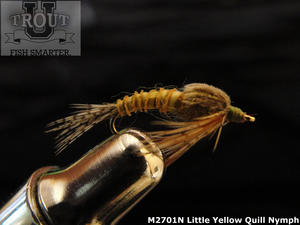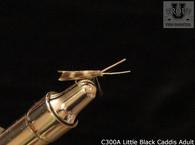
After mayfly eggs are laid, they hatch within usually 2 or 3 weeks and start the next cycle as nymphs. There are four basic types of mayfly nymphs - the burrowers, swimmers, clingers and crawlers. Each type has their own particular habitat and behavior. We have discussed the habitat and the behavior of the swimmer, the crawler and the burrower nymphs in the previous blogs. Now we will discuss the mayfly clinger nymphs.
The clinger nymphs typically are flatter than other types and have longer more spread out tails. The thorax is weighted to help keep it on the bottom where the clingers spend their lives. As a side note, it is interesting how God prepares each creature to be best adapted to its lifestyle. The weighted thorax would not be suited for a swimmer nymph! This large groups of nymphs include the Western March Browns, Eastern March Browns, Light Cahills, Cream Cahills, Heptagenia Group, Quill Gordons, Slate Duns, Yellow Quills, Dark Red Quills, Ginger Quills, & Little Yellow Quills.
Clinger mayfly nymphs live underneath rocks and pebbles on the bottom of the stream. Since they require a lot of oxygen, they are almost always located in moderate to fast moving water. They can be found under rocks in the riffles and runs of the stream where they hide, coming out of their hiding places to feed. They prefer to feed under the low light conditions of dusk or even at night.
When they are ready to hatch, they move from their fast water habitat to slower moving water such as the pockets or the edges of the fast water near banks. This migration takes place anywhere from a few days to several hours before the actual hatch. The clinger nymphs do not drift through the currents but they rather crawl on the bottom to get into position to hatch. To hatch, the clingers will swim to the surface slowly in a crude fashion using their tails and gills. Most of the hatch will occur on the surface; however, some will hatch in mid depth or even the bottom of streams.
Fish the clinger nymph patterns on the bottom in a dead-drift fashion using plenty of weight. Zero in on the pockets behind boulders and rocks, and along the banks, and the seam edges of the faster moving water. Let your fly gradually progress from the fast water into the seams and into the slower water immediately adjacent to the fast water all the while ensuring that the fly stays on the bottom.
Add a small amount of weight a few inches above the fly and cast up and across in the current seams and mend the line a couple of quick times to help get it down on the bottom.
Troutnut.com Store





